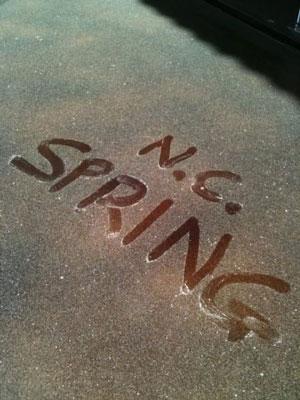
A combination of mild winter weather and an early March warm-up are resulting in an intense and early season for allergy sufferers. These conditions allowed trees to pollinate earlier than usual. In eastern North Carolina, pollen levels usually peak in early to mid-spring when most of our native trees such as pines and oaks are flowering. Some of the biggest spring allergy offenders also include grasses and weeds. The trees, many of which are widespread in Greater Fayetteville, also include birch, beech and cedar.
This year, the pollen was noticeable a week before spring had sprung. Pollen levels are considered high when daily counts exceed 270 grains per cubic meter. Pollen counts at state environmental laboratories in Raleigh have already reached leveled of 428 and 450. They could get much higher, though. The good news? Seasonal peaks like this usually only occur within a one- or two-week span.
With pollen on the rise, allergies won’t be far behind. People who are bothered by allergies may want to limit their time outdoors until pollen levels decline. State environmental experts say the worst times to be outdoors in the pollen are during early morning hours and when it is windy outside. Keeping doors and windows shut with air conditioners running helps to reduce pollen levels indoors. Rainy days, on the other hand, cause a drop in the pollen counts, because the rain washes away the allergens. And of course the rain washes away the residue on the roofs of our homes and cars…at least temporarily.
The immune system normally defends the body against harmful invaders, such as viruses and bacteria, to ward off illnesses. According to WebMD the immune system, mistakenly seeing the pollen as foreign invaders, releases antibodies — substances that normally identify and attack bacteria, viruses and other illness-causing organisms. The antibodies attack the allergens, which leads to the release of chemicals called histamines into the blood. It’s the histamines that trigger the runny nose, itchy eyes, and other symptoms of allergies. Allergic reactions result from specific types of pollen. The reaction leads to numerous irritating symptoms, such as sneezing, stuffy nose and watery eyes.
Some people have pollen allergies year-round, while others only have them during certain times of the year. For example, people who are sensitive to birch pollen will usually have increased symptoms during the spring when birch trees are in bloom. Similarly, those with ragweed allergies will be most affected during the late spring and early fall. A pollen allergy is sometimes referred to as hay fever.
If you’re one of the millions of Americans dealing with sinus problems, you know how miserable facial pain and clogged nasal passages can be. Allergies affect up to 30 percent of adults and 40 percent of children in the United States. Symptoms can be treated with medications and allergy shots. Many sinus sufferers have turned to nasal saline irrigation, a therapy that uses a salt and water solution to flush out the nasal passages.
One of the most popular methods is use of the Neti pot — a ceramic or plastic pot that looks like a cross between a small teapot and Aladdin’s magic lamp. Although nasal irrigation using the Neti pot has been around for centuries, its use is on the rise in the United States.